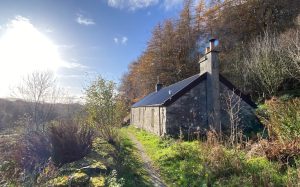Heart of Argyll Wildlife Organisation (HAWO) has taken over the ownership of Barrandaimh farmhouse – home of the Argyll Beaver Centre.
Originally owned by Forestry and Land Scotland (FLS), the sale was recently completed to Mid Argyll community group.
The group’s successful asset transfer request centred on the purchase of 0.52 hectares of land in Knapdale, including the buildings housing the Beaver Centre.
As well as restoring the land to wet meadow status, HAWO intends to further develop the wildlife ranger service and improve the environmental interpretation facilities.
It is also looking to continue to develop the buildings as an education and information centre, and create a community space that can accommodate visits from tourists, local people as well as groups from schools, colleges and other organisations.
HAWO spokesperson, Pete Creech, said: “This is a great opportunity for the local community to get even more involved in the Argyll Beaver Centre – the only face-to-face centre for this form of tourism in Scotland.

“It has been a hugely popular place since it was established in 2017 and we believe that through our success in making this a community venture and winning the buy-in of local people, we can make this an even more significant resource for visitors and for the community.
“Taking ownership through this successful Community Assets Transfer Scheme application not only opens up access to funding but also bolsters the group’s enthusiasm and commitment – energies that will really drive us forward over the coming months and years.
“We would like to think that other community groups look at our experience as being inspirational and that it encourages them to take a closer look at FLS’s asset transfer process.”
The group plans both to raise awareness of the beavers and Scotland’s rainforest that surrounds the site, and to foster an appreciation and understanding of the value of and need for ongoing conservation work.
Other plans include establishing partnerships to maintain the area’s path networks, developing interpretation that explores the landscape’s history, and installing simple pod-type accommodation for use by visiting wildlife tourists and locals who are looking to experience this unique place ‘out-of-hours’.